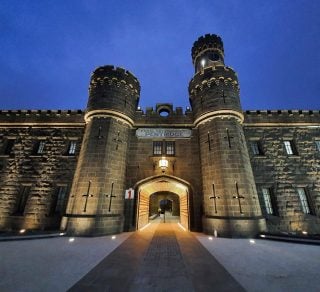Written by Michael Veitch, author and playwright. This article was first published in the National Trust of Australia (Victoria) Magazine (Autumn 2023 issue)
In this realm of stone and iron, the first thing that strikes you is the hush. Not the hush of a quiet forest, nor even the solemn airiness of a great cathedral. Stepping inside the cool bluestone walls and peering warily up to the high and plain vaulted ceiling, the hush of Pentridge bears down like a great, dead weight.
This is a mute hush: oblivious, inviting no judgement, and entirely unmoved by the emotions that close around you like ghosts as you move across the ancient-looking floor – a jigsaw of oversized stone slabs, polished smooth by a century and a half of countless shuffling feet. Today, those feet are still, and the voices of the prison’s inmates long silent.
But their stories are set to be immortalised. From the Gold Rush up until the threshold of the 21st century, Pentridge Prison brooded over Melbourne as a grim and silent presence. Like a couple of hateful convicts shackled together, gaol and city became intertwined, each tolerating the other, but without so much as a glimmer of warmth.
Yet to generations of Victorians, Pentridge remains the stuff of living memory, whether via a direct connection or simply through its endless reference over years of headlines and sensational news bulletins. The very word ‘Pentridge’ buried itself into the patina of our lives, becoming synonymous with a dumb sense of oppression which, albeit officially sanctioned, seemed long ago to have outlived its purpose.
As children, at the beginning of adventurous road trips north, our parents would point out the prison’s looming outer ramparts – great cliffs of bluestone – as we sped along Sydney Road, issuing ghoulish forebodings of what awaited us inside those walls should we fail to behave.
Yet, how much did we really understand of Pentridge, or what took place within its walls?
On my advance tour before Pentridge’s re-opening, I am led down a corridor of cells of what was known as B Division. The riveted steel doors, now permanently ajar, beckon me inside one of them. My first reaction is, I am told, the most typical: an intake of disbelief as my eyes instinctively seek out more space than the pitiful few yards laid before me: barely a cupboard’s worth, it seems. ‘No’, I breathily exhale. ‘There must be more than this?’ But no, it was into these dismal boxes of stone that generations of men and some women were kept, often for years, for up to 23 hours a day. The only source of light struggles feebly down from a single barred window, just a few feet above our heads, but as inaccessible as a distant star.
The greatest shock however echoes not from the distant past, but recent memory. Cheap pinboards secured to the Victorian-era cell walls have been kept as they were left, an incongruous reminder of the gaol’s final years. Upon these, inmates attached reminders of normality, pictures of girls cut from magazines, notes from mother. In clear blue biro, graffiti spells out the names of girlfriends and football stars, as well as oaths of revenge and retribution. ‘1996. It will happen’ declares one cryptic pledge. My mind pulls me back to what occupied my own carefree life in 1996, spent just a few miles from where I now stand. Pentridge closed only the year after.
In preparation for Pentridge’s transformation, brilliantly researched displays have been assembled exploring the themes of the prison stretching back to its inception in the 1850s. In glass cases, objects once frantically hidden from the prying eyes of warders are now free to be examined at leisure. Homemade knives, fashioned from every conceivable material, sit beside impromptu drug paraphernalia, including a couple of hollowed out tennis balls that once contained drugs – lobbed over the out wall by friends on the outside.
An evocative display on the handful of women who passed through the place features enlarged images of doleful eyes looking out from under the brims of 1920s cloche hats.
We are also reminded of that other population, the warders, whose faces seem to differ from those of the inmates they guarded only by the colour of their uniforms. But in today’s Pentridge, there are no heroes. No heroes, and no villains.
The role entrusted to the NTV in re-engaging the community with an institution as familiar – indeed, controversial – as Pentridge Prison is one of enormous privilege and profound responsibility.
In its next incarnation, Pentridge will become neither theme park, nor a house of judgement. After 170 years, it is now time for those forbidding walls to transform into a place of human story.
The creative vision of Art Processors will be but one of the elements reducing the otherwise overwhelming experience of captivity to that of a single human voice. As we walk through at our leisure, we will hear from those for whom these cells, corridors and gangways were once home, often for a significant portion of their lives. As one former inmate will tell us, “When you go into a place like this, you kind of melt…”
It is impossible to predict what the range of emotions and reactions will be for the many people soon to experience Pentridge for the first time. It is reasonably safe to assume however, that none of them will remain unmoved.


